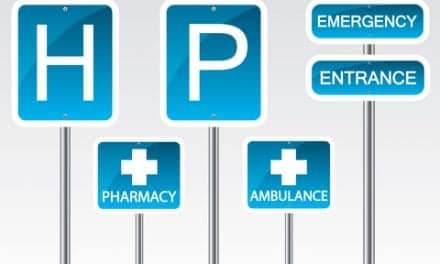PHOTO CAPTION: Crises tend to evolve quickly, and situations can change rapidly. Leaders should be honest and focus on the facts, and their messages should be action oriented.
On March 11, 2020, the World Health Organization officially declared COVID-19 a pandemic. The resulting actions by local, federal, and national governments and organizations worldwide threw most of us into what seemed like an otherworldly experience not in alignment with the comforts of a modern society. Many businesses closed down, schools began educating students by remote means, citizens were told to shelter at home, and healthcare centers faced a myriad of challenges ranging from altering the way services were delivered, temporary furloughs of staff, personal protective equipment shortages, inpatient/ICU bed capacity limitations, to permanent closure of practices due to loss of revenue.
While the COVID-19 pandemic is certainly the first time that most of us have had to experience such levels of sustained crisis, other disasters that have had similar effects on our population and our healthcare services have occurred over time in more regional locales. Consider Hurricane Katrina, a category 5 storm that devastated parts of Louisiana, Mississippi, and Alabama in 2005. Katrina killed more than 1700 people1 and displaced more than a million people, many of whom had little to no access to healthcare services.2 Also significant was Hurricane Maria, a category 4 storm that pummeled Puerto Rico in 2017 killing nearly 3000.3 Compounding the devastating effects of the hurricane was the fact that even before the storm, 44% of Puerto Rico’s population lived below the poverty line.
In addition to storms, our country has experienced several horrific wildfires in recent years. In 2018, the Camp Fire destroyed the entire city of Paradise, California, burning 19,000 structures including 11,000 homes and killing 85 people.4 Sadly, in August of 2020 another horrific wildfire outbreak occurred on the West Coast, devastating parts of several states. Disasters strike more frequently than we may think and take other forms, including but not limited to blizzards, floods, earthquakes, tornados, chemical spills, and wars or political/social conflicts.
The effects stemming from disaster situations are both immediate and long-term and certain populations are at higher risk for negative outcomes. Research shows that people with a low socioeconomic status tend to live in areas that are more prone to natural disasters, possibly because the cost of living in these areas is lower than other areas that are less likely to be hit by a hurricane, earthquake, fire, flood, or tornado.4 Low socioeconomic status also correlates to increased substance abuse and increased risk of physical or psychological injuries and psychological trauma following a disaster.5,6 Minority populations are likewise at greater risk of suffering from post-traumatic stress disorder (PTSD) and for reporting a “confluence of disaster exposure factors including direct exposure and concern for safety of their family” than whites.7
Loss of physical environmental components can have a devastating impact on one’s health. In many of the disaster situations described above, people lost their homes; their places of employment; their access to food, clothing, and other necessary supplies for living; and lost access to healthcare facilities or services. Psychological effects are also seen after a crisis situation. Depression, anxiety, PTSD, and sleep disorders are prevalent in both children and adults.8 The time it takes to rebuild, reignite the economy, and physically recover from injuries further contribute to the psychological stress disaster victims experience.
As healthcare practitioners and leaders, it is imperative that we remain mindful of what our potential and current clients are experiencing as we design interventions and operate our practices. Furthermore, we have to be conscious of the effects a disaster may have on us, the healthcare workers. We must remember that healthcare workers are human, too. Even without considering the selfless roles as front line workers, we must acknowledge that they too may be experiencing the physical, contextual, and psychological traumas that their clients are experiencing.
Leadership skills are more critical than ever during times of disaster. As leaders and managers, we must ensure that not only our businesses or departments survive, but we also must intentionally support our staff. Additionally, as clinicians, we must be sure that we are properly leading our clients through the rehabilitation process that is likely to be more stressful during a time of local, national, or global crisis than it typically would be. So, what does this kind of leadership look like? I’ve studied leadership approaches and theories extensively, and I find that I continuously reach for Kouzes and Posner’s Five Leadership Practices9 as I map out my leadership actions. These five practices have proven to be successful time and again. I’d like to share some practical strategies aligning with the Five Leadership Practices that can be used to better mitigate the negative effects of disaster.
Model the Way
According to Kouzes and Posner, “Titles are granted, but it’s your behavior that earns you respect.”9 It is critical that leaders set the example for the behavior expected among staff and clients. During times of crisis, such behavior should exemplify a sense of calmness and leaders should offer reassurance to their teams. When leaders are stressed and that stress is displayed through negative behaviors, the team is highly vulnerable to assuming those stress behaviors which then become counterproductive to success. Instead, leaders need to remain cool, calm, and collected and have a reassuring tone of voice. Take an optimistic perspective and focus on the positives in the situation.10 For example, rather than focus only on the total number of people infected with COVID-19, we can instead direct our focus on the severity of the virus, the hospitalization rate, and the death rate.
While these statistics are still staggering, they offer a bit more optimism showing that while more people are testing positive every day, the severity and rate of hospitalization and death are not climbing proportionately (at the time of this writing).11 That is a bit of good news upon which to focus. This is not to say that we need to ignore all of the other statistics and facts regarding the situation, but my point is that when we look for and highlight the positives, the optimistic tone can help us remain calm and reassured that we will get through the current crisis. In fact, research shows that optimism of healthcare workers “leads to higher levels of performance, affects the level of patient satisfaction, and improves other work-related performances.”12 As we model the way for our teams, it’s also important to exude confidence as a leader.13 Times of disaster can certainly cause us to feel exactly the opposite, but despite the uncertainty we face as the situation evolves, we can still be confident in our leadership skills. Helping your team know that their leader is confidently at the helm will go a long way toward reducing unnecessary stress.
Communication during times of crisis is also critically important. It’s not only what leaders communicate, but how they communicate. Transparency in communications will help team members feel more confident in the message being delivered and more reassured that the leader is doing their part to stay engaged in mitigating the situation.10 Leaders should be honest and focus on the facts, and their messages should be action oriented. In other words, keep the team informed about what decisions are being made, be honest about what you still don’t know and what you do, and keep them up to date on the plans for moving forward as they are made. Crises tend to evolve quickly, and the situation can rapidly change; it is OK to admit to your team that a previously communicated plan must be changed because of new data or new conditions.
Inspire a Shared Vision and Enable Others to Act
Kouzes and Posner asserted that “Unity of purpose is forged when you show your constituents how the dream is a shared dream and how it fulfills the common good.”9 I have found it to be especially important during times of crisis to involve the entire team in collaborative planning. Team members need to feel heard and to be shown that their opinions matter. When the entire team participates in the decision-making process, there is a greater sense of unity and willingness to embrace the plan for the common good. Another way of helping our team members feel engaged and important is to help them find ways of contributing to the process. Assist them with finding roles and responsibilities that can be helpful to others.14 Routines are most likely disrupted, which sometimes leads to a feeling of being inept or inadequate such that a little help in identifying “what next” is greatly appreciated. It is also important to keep in mind that expectations must be realistic. During trying times, perfectionism shouldn’t be the goal; rather, we need to be mindful that since our conditions are atypical, we need to be realistic with what can truly expect from our environment, our supports, and our staff.
Challenge the Process
According to Kouzes and Posner, “Leaders venture out; they don’t sit idly by waiting for fate to smile on them.”9 Times of crisis and disaster require flexibility and innovation. We have to remember that situations change quickly, and therefore being set in our ways or expecting a particular outcome might not be the best method for moving forward. At the same time, we need to be looking for creative and innovative solutions that can improve the situation in either the short or long term. For example, it may be beneficial to explore alternative ways of delivering your healthcare services or expanding your services into alternative environments. With the recent COVID-19 crisis, we have seen an explosion in the use and reimbursement of telehealth. After natural disasters, increasing community health centers and services have had a significant impact on the ability to support population health.15 Disasters may force typical operations to cease, but they may open up the opportunity to still provide important healthcare services that may have long-lasting positive outcomes.
Encourage the Heart
There is no doubt that stress levels are high during times of disaster or crisis. Therefore, it is important for leaders to encourage the hearts of their teams. According to Kouzes and Posner, “It’s part of your job as a leader to show appreciation for people’s contributions and to create a culture of celebrating the values and victories by creating a spirit of community.”9 Be sure that you are offering kind words, support, kudos to those who contribute to the solution, and most importantly, grace. Just as we need to be flexible and adaptable with the situation, we need to be so with our staff. Simply showing up to work and providing care to clients during a disaster is cause enough for celebration and thanks. Offer a little more grace than you might typically offer for challenges such as tardiness, childcare issues, dress code, etc. Ask yourself if strictly adhering to every one of your policies is critical in the moment. Remember to encourage self-care, empathy, and occupational balance because we know that if healthcare workers aren’t healthy, physically and mentally, then we are not able to provide the highest level of care to our clients.
Conclusion
In a perfect world, we would all live peaceably without disaster or crisis. However, since this utopic dream doesn’t exist, we must have a plan in place for how we can best lead our rehabilitation teams through times of large-scale difficulty and despair. Grace, empathy, encouragement, flexibility, creativity, honesty, and transparency are all characteristics and actions that leaders can take to better armor teams against the devastating stresses of disaster while fostering the best client care and population health possible. RM
Melissa Sweetman, PhD, OTD, OTR/L, CLA, has been an occupational therapist for 25 years and has primarily worked as a multi-state regional director in the post-acute care setting. Since transitioning into academia, she has worked as a Program Director and Assistant Professor for a post-professional OTD Program and currently serves as the Founding Program Director and Associate Professor for the entry-level Doctor of Occupational Therapy program at Wingate University. For more information, contact [email protected].
References
- Huelskoetter T. Hurricane Katrina’s health care legacy. Center for American Progress. https://www.americanprogress.org/issues/healthcare/reports/2015/08/20/119670/hurricane-katrinas-health-care-legacy/. Published August 20, 2015. Accessed July 2, 2020.
- MacDonald I. Hurricane Katrina and its impact on healthcare: 10 years after the storm. Fierce Healthcare. https://www.fiercehealthcare.com/healthcare/hurricane-katrina-and-its-impact-healthcare-10-years-after-storm. Published August 24, 2015. Accessed July 2, 2020.
- Puerto Rico a year after Hurricane Maria. Amnesty International. https://www.amnesty.org/en/latest/research/2018/09/puerto-rico-a-year-after-hurricane-maria/. Published date not given. Accessed July 2, 2020.
- Substance Abuse and Mental Health Services Administration (SAMHSA). Disaster technical assistance center supplemental research bulletin. Greater impact: How disasters affect people of low socioeconomic status. SAMHSA; 2017:3-16. Available at: https://www.samhsa.gov/sites/default/files/dtac/srb-low-ses_2.pdf. Accessed July 2, 2020.
- Zhang W, Kinney PL, Rich DQ, et al. How community vulnerability factors jointly affect multiple health outcomes after catastrophic storms. Environ Int. 2020;134:105285.
- Nomura S, Parsons AJQ, Hirabayashi M, Kinoshita R, Liao Y, Hodgson S. Social determinants of mid- to long-term disaster impacts on health: A systematic review. Int J Disast Risk Re. 2016;16:53-67.
- Davidson TM, Price M, McCauley JL, Ruggiero KJ. Disaster impact across cultural groups: Comparison of Whites, African Americans, and Latinos. Am J Community Psychol. 2013;52(1-2):97-105.
- Makwana N. Disaster and its impact on mental health: A narrative review. J Family Med Prim Care. 2019;8(10):3090-3095.
- Kouzes JM, Posner BZ. The leadership challenge. 5th ed. San Francisco, CA: The Leadership Challenge; 2012.
- D’Auria G, DeSmet A. Leadership in a crisis: Responding to the coronavirus outbreak and future challenges. McKinsey & Company. https://www.mckinsey.com/business-functions/organization/our-insights/leadership-in-a-crisis-responding-to-the-coronavirus-outbreak-and-future-challenges. Published March 16, 2020. Accessed July 6, 2020.
- Centers for Disease Control and Prevention. Hospitalizations. Coronavirus Disease 2019 (COVID-19). https://www.cdc.gov/coronavirus/2019-ncov/covid-data/covidview/index.html#hospitalizations. Published July 3, 2020. Accessed July 6, 2020.
- Boldor N, Bar-Dayan Y, Rosenbloom T, Shemer J, Bar-Dayan Y. Optimism of health care workers during a disaster: A review of the literature. Emerg Health Threats J. 2012;5(1):7270.
- Leadership in times of crisis: How to lead efficiently. Engagedly. https://engagedly.com/leadership-in-times-of-crisis/. Published date not given. Accessed July 6, 2020.
- Koehn N. Real leaders are forged in crisis. Harvard Business Review. https://hbr.org/2020/04/real-leaders-are-forged-in-crisis. Published April 3, 2020. Accessed July 6, 2020.
- Meyers, T. Natural disasters are getting worse. Health centers are joining the response. DirectRelief. https://www.directrelief.org/2019/11/natural-disasters-are-getting-worse-health-centers-are-joining-the-response/. Published November 29, 2019. Accessed July 6, 2020.





